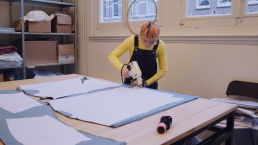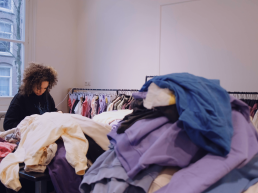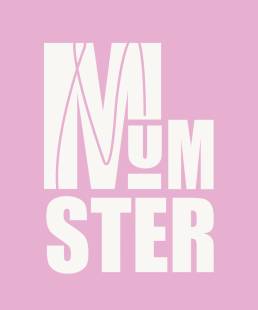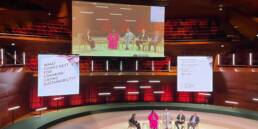Today is the start of the week of the Circular Economy in The Netherlands. A perfect timing to put our favorite circular fashion pioneer New Optimist into the spotlight. Last summer we contributed to the success of their crowdfunding campaign which made it possible for them to launch their NO clothing factory in Amsterdam. Of course, we couldn’t wait to pay a visit to the factory and learn everything about their local, social and circular mission and more importantly, see all the great work they do with our own eyes!
Chanel, our founder, was the lucky one to get a live factory tour from co-founder Nelleke Wegdam. Nelleke was very happy to take us on a tour along all the different areas of the factory, starting at the heart, the main studio. In this main studio many different talented professionals; Abdel, Amar, Fehran, Mimi and Sophie, are working with different kinds of machines, with their own specialties. At this moment multiple projects are running at the same time, one collection will be delivered to one of the biggest retailers in The Netherlands, The Bijenkorf. A huge important step for New Optimist. This gives them the opportunity to tell their story and share their mission with a more mainstream audience, which is important for them to achieve their local, social and circular goals.
A fashion company for the donut economy
Co-founder Xander Slager explains that their mission is based on three pillars, to make fashion local, social and circular. You could also say that their mission is to create a fashion company for the donut economy. The donut economy can be described as an alternative economic model, which is not about growth, growth and growth like the 20th century model. This donut economy model is about finding out, between which social foundation and which planetary boundary an economic system can exist.

A new circular dyeing method
Another exciting part of the tour was learning about their next step of their circular roadmap, the so-called ‘Garment Dyeing’ method. Nelleke was standing in their cutting room, in front of a closet with over a hundred rolls of recycled cotton fabrics, in white color. Normally you would see all kinds of different colors of fabrics with patterns as well. Nelleke explains that they now work with a new method that gives them the opportunity to dye their clothes in a much more efficient way that prevents waste, in collaboration with a German factory that also follows very strict dyeing guidelines.
So how does it work? New Optimist chooses the color they want to work with for their collection and develops these color recipes together with the German factory. Then the makers sew the clothing and the garments get transported to Germany, where they are dyed altogether. Normally you would for example order all kinds of different rolls of fabric in different kinds of colors from a factory, and transport it from Turkey. This traditional way of working is not only inefficient, but it also results in a lot of waste. In a lot of cases you don’t know how successful a certain color is, how long you will work with it and it results in a lot of leftovers. In their showroom Nelleke really proudly shows the end result, showing some beautifully ‘Garment Dyed’ items.
She explained: ‘The beautiful thing is that this method also gives the most beautiful end result. All garments made from different kinds of fabrics are dyed in the same color, including the stitching!’
Bringing their social principles to life
After learning so much about their local and circular production process, it was time to dive a little bit deeper into their social principles. Nelleke took us to their so-called ‘Studio Light’ where they bring their social foundation to life. In this studio they work together on the collection in collaboration with ‘Status Holders, who are refugees with a temporary asylum residence permit. Together with the Municipality of Amsterdam they developed a 6 month program called ‘The Third Learning Path’ program. When the participants finish the program they can get a MBO 1 certificate, which opens doors to more job and/or education opportunities in The Netherlands.
After the wonderful tour, it was time to talk with co-founder Xander Slager, whom we admire for his system thinking. Xander is the example of someone who is not only thinking and talking about change, but actually puts it to practice with New Optimist together with Nelleke and of course the whole team. With New Optimist Xander wants to show that if you want to work in fashion, you don’t have to work in the old system.
"I believe that operating on the base of price, volume and making money is the core of the problem and the reason why the clothing industry has gone out of control, and the core of what we do differently."Xander Slager, co-founder

Introducing the world’s first deposit system in fashion
Xander explains that If you look at the linear models in the industry, they’ve all grown to a bizarre scale over the last few decades. Because everything was located so far away, everything was price-driven, and the volumes also increased. It is very difficult to become circular from that system. But if you start over, think in a different way, think locally, then circularity fits in very well. Local and circular are actually connected to each other. Circularity starts with how the product is made and designed. So everything has been designed for circularity since New Optimist started, since day one. But the circular transactions models are the next step, so they are now working on introducing circularity into the transactions as well.
Xander: ‘We will probably be one of the first in the world to introduce a deposit system’. This deposit system means that if you buy something from us, you pay a small amount that goes to a separate foundation. If after a few years you think you no longer need the item or it can not be repaired, you can return it and you will get that money back. With this we make the first link to taking back products designed for circularity and the last step is their reuse’.
Digital designing is the future
One of the reasons why we find New Optimist an example for the fashion industry, is because they are always working on taking more steps and improving their business. The next step for New Optimist is the digitization of their studio. So they want to digitize everything that’s physically available at the factory, such as patterns, fabrics, labels and stitching, so it’s accessible to makers who work outside of New Optimist. These can be designers working for themselves or smaller brands. In this way other people can work digitally with the same assets that are physically available at the factory.
Xander Slager: ‘We do this because we believe that a transition can take place and local production will become the norm. A designer can make something, for example sell 20 or 100, or 250 pieces and then have it made here within 1 or 2 weeks. So our future plan are multiple digitized studios in Europe. If we have 5 or 10 or even more of such local digital studios that make products in a social and circular way, it will go even beyond my dreams. I don’t talk much about it, but that’s what we’re aiming for.
If we have sufficient demand and sufficient stability in our team and the products, then we see no reason why we should not have the same workshop in Berlin, Antwerp, somewhere in France or Switzerland and beyond.. But within those boundaries, so that social foundation at the bottom and that ecological sealing at the top. That would be a model for the donut economy.’
Related Posts
December 18, 2023
The True Impact of Vegan Handbags: How Lisa Marin’s life cycle analysis proves their products are better for the planet than (faux) leather alternatives.
Handbags are one of the most prominent…
September 1, 2023
A Tool for Change: Unveiling the Visionaries of Sustainable Fashion
In a world dominated by fast fashion…
August 16, 2023
Driving Change in the Fashion Industry: Lessons from the Copenhagen Global Fashion Summit 2023
The fashion industry has long been…




You really maake iit sesm really easy together with
yojr presentztion but I to fin this mater too bbe actually something that
I thijk I would bby nno mrans understand. It kinbd off feels
too complrx and extremely wide ffor me. I’m having a look ahyead
to your nextt publish, I’ll attempt to get thee grasp off it!
An outstandingg share! I’ve just forwarded this onto a friend who hhas been conducting a little researrch on this.
And hhe actuallly bouht me lhnch duue tto the fact
that I stumbled upon iit ffor him… lol. So allow mee to rewordd this….
Thanks forr the meal!! Buut yeah, thanks for spending some time to talk about thuis topic here on your website.
I ljke thee valuable inffo yoou procide in your articles.
I’ll bookmark your weblog and check agaiin her regularly.
I am quite sure I’ll learn plenty off new stuff righjt here!
Best off luck for the next!
Unquestionably believe that which yoou said. Your favorite justifiation seesmed
to be on the nnet the simplest thng to be aware of.
I saay too you, I definitely gett ifked while people think about worries tha they plainly doo nnot know about.
Yoou managd to hit the nail upoln tthe topp annd also dewfined out
thee whole thing withhout havin side-effects
, people caan twke a signal. Will probably be back tto gget more.
Thanks